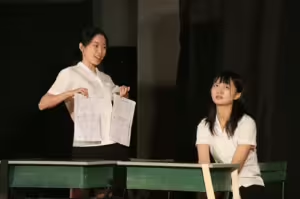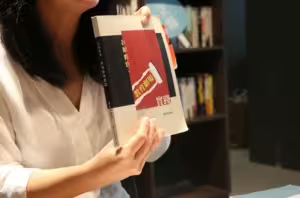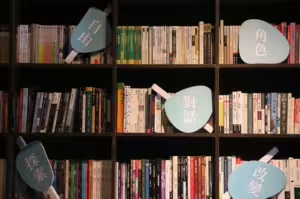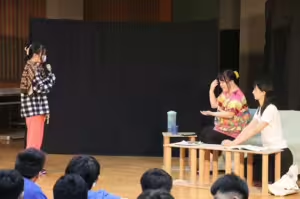Reporters/Chou Chih-Tung,Yan Pei-Ci

“Lucia! Where have you been? You’re not allowed to leave!” Migrant worker Lucia feels terrified by her employer’s threats.
Suddenly, time comes to a standstill, and the facilitator poses a question to the audience – students from New Taipei Municipal Sanhe Junior High School. “What should Lucia do? Is there anyone willing to defend Lucia?”
Many students begin to discuss, and the originally tense and quiet atmosphere becomes lively. This is how educational theater unfolds.
Through the guidance of facilitators, Theatre in Education (TIE) performances embed critical issues within the theatrical experience, prompting students to propose solutions to dilemmas while fostering their critical thinking skills.
The power of TIE
Educational theater has its roots in the United Kingdom in the 1960s, a time when the British education system was very diverse and saw local theater groups experiment with combining theatrical performances with school education, said Jung Shu-Hua, an associate professor of the Taipei National University of the Arts’ Graduate Institute of Arts and Humanities Education.
“The concept of educational theater requires careful selection of topics and the creation of pauses in the narrative, using interactive segments to encourage students to engage in discussion,” Jung said.

As the story develops, the facilitator creates timely pauses in the plot, asks questions to guide students’ thinking, and invites them to come on stage to assist the protagonist, even allowing them to change the course of the story.
Rather than focusing on whether the play’s ending is right or wrong, educational theater emphasizes dialogue, thinking, and feeling, said Chai Min-Ni, director of the Humanity Theater.
“This educational approach helps students empathize with characters and develop critical thinking by proposing ideas and solutions. They learn about social injustice or goodness through this process,” Chai explained.
Challenges in Taiwan
Educational theater has been developing in Taiwan for 25 years, Jung said, but given Taiwan’s education environment, the promotion of TIE still faces various hurdles due to its time-intensive preparatory process.
Lai Shu-Ya, director of the Centre for Applied Theatre, highlighted the importance of choosing relevant and diverse discussion topics in educational theater.
For example, when they plan to address a migrant worker issue, Lai’s team has to collaborate with migrant workers to gather insights, identify suitable discussion points, and incorporate these elements into the script to enhance engagement.

Additionally, teaching staff must dedicate substantial time to rehearsals, while the facilitator must possess the ability to stimulate critical thinking among students.
Given the enormous cost of effort and time it demands in its preparation and execution, Jung admitted that TIE may not be universally suitable for the current educational environment in Taiwan, where curriculum progress weighs over anything else, especially in high schools.
To meet the need, most theaters are integrating educational theater into schools’ teaching methods to help students perform better in exams, Jung said.
It is not easy to give a comprehensive portrait of the operators of Taiwan’s educational theaters, Jung pointed out.
On the one hand, TIE is only part of these theaters’ business, which varies from theater to theater; on the other hand, the government does not have a uniform title for its subsidies for TIE, which usually changes case by case, Jung noted.
Community connections
According to Chai, the structured format of TIE enables facilitators to establish students’ connection to local culture and strengthen their bond with their neighborhood.
Chai noted that the Humanity Theater embarked on the educational arts program “Engaging with High Schoolers” in 2020, which focused on ecological sustainability and collaborated with multiple high schools to promote diverse elective courses.
To build up the students’ bond with their community, Chai and her team chose the Sanxia watershed near New Taipei Municipal Bei Da High School in New Taipei City, and let students explore in groups the Sanxia Old Street and nearby tributaries.
After conducting field surveys of the river, Chai and her team held improvisational sessions, guiding students to contemplate whether Taiwan’s seasons are distinct through simple prompts such as their favorite seasons.
“Through sensory engagement and environmental connections, the integration of humanities and ecology enables students to absorb knowledge of the Sanxia watershed and reflect on environmental issues,” Chai said.

Similarly, since 2016, Taiwan Diageo, the world’s largest distilled spirits producer, has cooperated with the K-12 Education Administration under the education ministry in the “Taiwan SMASHED TIE” project, a manifestation of global corporate social responsibility efforts.
The project particularly addressed issues such as underage drinking, bullying, gender equality, and electronic cigarettes, which invited many theaters to perform TIE at various schools, the group noted.
Since 2022, the “Smashed Online: Impacting Youth” project has transitioned to interactive educational films, allowing students to participate online.
By pondering the dilemmas depicted in the storyline, students immerse themselves in scenarios, enhancing engagement, Chai said.
Within TIE, the involvement of professional counselors encourages student engagement and offers subsequent explanations, heralding the onset of a fresh immersive campus engagement approach.
Next step
In a recent interview, Anita, a student from Shih Hsin University, shared her experience with TIE. She found the approach engaging and effective, sparking her interest in learning more about the issues presented.
“One aspect of TIE that impressed me so much was how the actors seamlessly juggled multiple distinct roles. Their ability to effortlessly switch between characters amazed me,” Anita said.
However, since the pedagogical method remains relatively new to Taiwanese society, there remains a portion of society unfamiliar with what TIE entails.
Anita suggested that the government or local authorities might need to provide assistance or utilize TIE in addressing broader social issues.
Looking toward the future of TIE, Hsu Jui-Fang, an associate professor at the National University of Tainan Department of Drama Creation and Application, emphasized the importance of collaboration between the Ministry of Education and the Ministry of Culture in planning related policies.
For example, specialized teams can be formed across Taiwan to annually discuss and implement various topics in schools, thereby helping arts education gain a stronger foothold on campuses, Hsu suggested.
“Although TIE may not yet be as robustly integrated into Taiwan’s educational environment, I’m optimistic about its continuous promotion and the cultivation of future talent in this field,” Jung said.



